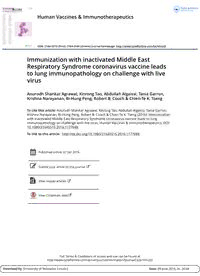
2016 Immunization with inactivated Middle East Respiratory Syndrome coronavirus vaccine leads to lung immunopathology on PDF
Preview 2016 Immunization with inactivated Middle East Respiratory Syndrome coronavirus vaccine leads to lung immunopathology on
Full Terms & Conditions of access and use can be found at http://www.tandfonline.com/action/journalInformation?journalCode=khvi20 Download by: [University of Nebraska, Lincoln] Date: 09 June 2016, At: 20:04 Human Vaccines & Immunotherapeutics ISSN: 2164-5515 (Print) 2164-554X (Online) Journal homepage: http://www.tandfonline.com/loi/khvi20 Immunization with inactivated Middle East Respiratory Syndrome coronavirus vaccine leads to lung immunopathology on challenge with live virus Anurodh Shankar Agrawal, Xinrong Tao, Abdullah Algaissi, Tania Garron, Krishna Narayanan, Bi-Hung Peng, Robert B. Couch & Chien-Te K. Tseng To cite this article: Anurodh Shankar Agrawal, Xinrong Tao, Abdullah Algaissi, Tania Garron, Krishna Narayanan, Bi-Hung Peng, Robert B. Couch & Chien-Te K. Tseng (2016): Immunization with inactivated Middle East Respiratory Syndrome coronavirus vaccine leads to lung immunopathology on challenge with live virus, Human Vaccines & Immunotherapeutics, DOI: 10.1080/21645515.2016.1177688 To link to this article: http://dx.doi.org/10.1080/21645515.2016.1177688 Published online: 07 Jun 2016. Submit your article to this journal View related articles View Crossmark data SHORT REPORT Immunization with inactivated Middle East Respiratory Syndrome coronavirus vaccine leads to lung immunopathology on challenge with live virus Anurodh Shankar Agrawala, Xinrong Taoa, Abdullah Algaissia, Tania Garrona,e, Krishna Narayanana, Bi-Hung Pengb, Robert B. Couchc, and Chien-Te K. Tsenga,d aDepartments of Microbiology and Immunology, University of Texas Medical Branch, Galveston, TX, USA; bPathology, University of Texas Medical Branch, Galveston, TX, USA; cInternal Medicine, Division of Infectious Disease, University of Texas Medical Branch, Galveston, TX, USA; dCenter for Biodefense and Emerging Infectious Disease, University of Texas Medical Branch, Galveston, TX, USA; eDepartment of Medical Laboratories Technology, College of Applied Medical Sciences, Jazan University, Jazan, Saudi Arabia ARTICLE HISTORY Received 8 February 2016 Revised 24 March 2016 Accepted 7 April 2016 ABSTRACT To determine if a hypersensitive-type lung pathology might occur when mice were given an inactivated MERS-CoV vaccine and challenged with infectious virus as was seen with SARS-CoV vaccines, we prepared and vaccinated mice with an inactivated MERS-CoV vaccine. Neutralizing antibody was induced by vaccine with and without adjuvant and lung virus was reduced in vaccinated mice after challenge. Lung mononuclear infiltrates occurred in all groups after virus challenge but with increased infiltrates that contained eosinophils and increases in the eosinophil promoting IL-5 and IL-13 cytokines only in the vaccine groups. Inactivated MERS-CoV vaccine appears to carry a hypersensitive-type lung pathology risk from MERS-CoV infection that is similar to that found with inactivated SARS-CoV vaccines from SARS-CoV infection. KEYWORDS coronavirus; Eosinophils; immunopathology; Middle East Respiratory Syndrome; vaccination Severe Acute Respiratory Syndrome (SARS) and Middle East Respiratory Syndrome (MERS) emerged in 2002 and 2012 respectively and were shown to be caused by a new coronavirus (CoV), now designated as SARS-CoV and MERS-CoV, respec- tively.1,2 The SARS epidemic was brought under control by using infection control methods. Because of continued outbreaks, vaccines for MERS are urgently needed. Preclinical evaluations of inactivated subunit and whole- virus vaccines for SARS have elicited serum neutralizing anti- body and protection against infection in monkeys, ferrets and mice challenged with infectious SARS-CoV. However, chal- lenged animals exhibited an immunopathologic-type lung reac- tion, and these results led to safety concerns relative to SARS- CoV vaccines.3,4 Moreover, due to the apparent epidemiologic control of SARS, along with these findings, clinical trials of SARS-CoV vaccines were placed on hold. With the rise of MERS, we decided to revisit the vaccines prepared for SARS studies and initially prepared a small batch of whole inactivated virus (WIV) for evaluation. We then began tests to determine if vaccination with inactivated MERS-CoV vaccine would result in immunopathology in vaccinated hosts similar to that seen with SARS-CoV. A mouse model for studies of MERS-CoV was not initially available since mice and other small animals lack the MERS-CoV receptor. For this reason, we developed a transgenic mouse model containing the human DPP4 receptor.5,6 Availability of this model provided the opportunity to assess whether an inactivated MERS-CoV vaccine would induce protection against MERS-CoV infection but also induce an eosinophil-containing pulmonary immuno- pathology as had similar SARS-CoV vaccines. This is the first report that a similar risk for immunopathology appears to exist for MERS-CoV-inactivated vaccines despite an ability to pro- tect against infection. The WIV stock was prepared by gamma (g) irradiating (5 mega-rads, cobalt-60) aliquots of Vero E6-derived, cell-free MERS-CoV (»1.2 £ 108 TCID50/ml). Inactivated supernatants, negative in rigorous isolation tests, were subjected to polyethyl- ene glycol/salt precipitation, purified by sucrose density centrifu- gation,7 and diluted in PBS to an equivalent of »1 £ 107 TCID50/ml. Western blot analysis by using a rabbit anti-MERS- CoV antibody demonstrated virus structural proteins including surface protein (S) and nucleoprotein (data not shown).5,8 For assessing the immunogenicity and protective efficacy of this WIV as well as its potential to elicit immunopathology upon live virus challenge of vaccinated animals, groups of six hCD26/DPP4 transgenic mice were immunized intramuscu- larly (I.M.) twice, three weeks apart. Mice received 100 ml of WIV only, WIV adjuvanted with alhydrogel 2% (alum) or with MF59 (Invivogen), or alum or MF59 only, according to proto- cols approved by the IACUC committee at the University of Texas Medical Branch. Sera were collected 21 days after the second immunization for micro-neutralization antibody tests; mice were then challenged intranasally (I.N.) with 103 TCID50 (100 LD50) of MERS-CoV,6 and sacrificed on days 3 or 6 CONTACT Chien-Te K. Tseng
